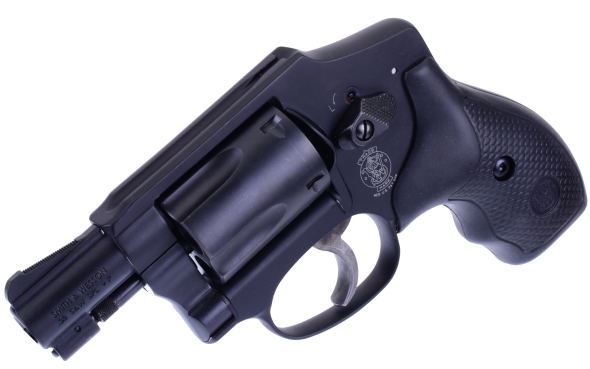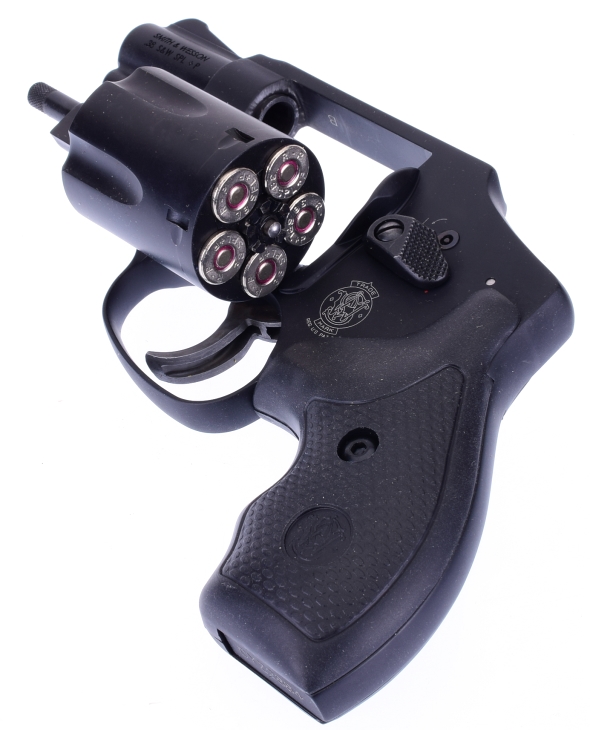All too often the ear deafening theorizing and debating about what makes an ideal concealed carry weapon, concludes in concurrence with a new wave, semi auto, high capacity, black plastic, goofy gun. Unfortunately, too many rabid high capacity autoloader evangelists carry their firearms in the trunk of their cars… back and forth to the range, with the backseat providing space for the huge amount of life threatening, multi attacker paranoia that accompanies them. If a person can’t rapidly put 5 shots into a 6″ center of mass on a 23″ wide target at 10 yards, more practice rather than more ammo is an appropriate solution to the problem.
The 38 Special snub nose Smith & Wesson Model 442-2 is a derivative of the all steel, 1950 frame 2″ barrel, .38 Chiefs Special. In 1957, the .38 Chiefs Special became known as the Model 36. In 1951 an aluminum J frame was created, which went on to become the Model 37. These were exposed hammer firearms. In 1955 the Bodyguard Airweight was introduced with an aluminum, hammer shrouding frame; the hammer was visible, but it could not be manually cocked. Below, a well worn Model 37 that was a close companion between 1966 and 1970.

In 1952, a steel enclosed hammer J frame was introduced as the Centennial. In 1957 this became the Model 40. In 1952 an aluminum frame version was also introduced as the Centennial Airweight. In 1957 this became the Model 42 Centennial Airweight. The enclosed hammer, aluminum alloy J frame became the Model 442 in 1993. In 1996, the Model 442 became the Model 442-1 when it was changed to a magnum J frame and cylinder and picked up a +P rating. In 2001 it became the 442-2 when a key lock and MIM parts were added to the assembly – Seen below 1).

|
Smith & Wesson 442 |
|
| Manufactured | Springfield, MA |
| SKU | 162810 |
| Type | Hammerless, Double Action |
| Caliber | 38 Special +P |
| Mag Capacity | 5 |
| Barrel Length | 1.875″ |
| Rifling | 1:18.75″ |
| Weight – Actual | 15 Oz |
| Overall Length | 6.31″ |
| Height | 4.5″ |
| Width | 1.3″ |
| Frame Material | Aluminum Alloy |
| Cylinder Material | Carbon Steel |
| Sight Rear | Grooved Frame |
| Sight Front | Ramped |
| Trigger Pull – D/A Only | 8 Lbs 12 Oz. |
| MSRP | $469.00 |
There are actually several SKU numbers associated with the current Model 442-2 including the subject configuration with an integral frame lock one that omits the frame lock, another with a cylinder cut for half moon clips, and one with an aiming laser device.
Functionally, the Model 442 is a simple to operate firearm. With the frame lock disengaged, there are no other safety devices to get in the way, there is no hammer to cock. The shooter merely aims/points and pulls the trigger.
Contrary to popular folklore, the Model 442 Airweight 38 Special is a terrible choice for new shooters and women who struggle with the weight of a larger revolver or autoloader. The Model 442 is too light for the 38 Special +P cartridge and has noticeable recoil and muzzle flash. Its benefit is in its small size which is intended for concealment, not to fit a person of small stature.

For folks who grouse about small autoloaders, short grips and large hands, the Model 442offers no solace. With two fingers on the grip in a hold that will not wrap knuckles, the pinky will curl under the butt and the web of the hand will be back from the square rise of the humpback frame.

I’m not a grouser, I’ve made my peace with small revolvers as a concession to concealment The grip is substantial enough for double action only operation and it makes for steady aim. Making it a point to shoot double action revolvers only double action, even those that permit single action operation, makes shooting the Model 442 second nature.
Observations…
Expecting typically good S&W quality, the Model 442 was a bit disappointing. The frame’s anodizing, as received was rubbed through at the crane and the face of the frame was scored bare through the anodizing where the back of the barrel made contact when tightened. The front sight was rotated right of centerline by perhaps 1ºor 2º.

Trigger pull felt much better pulling through rather than attempting to stage the pull. The trigger felt heavy, but uniform, very little take up and very little over travel. Staging the trigger pull, resistance varied; light, heavy, light and then very hard on break.
With ammo rounded up and the revolver ready, I’m going to work through the first ice storm of the winter, then get some accuracy, chronograph and gel block penetration data and wrap up in Part II.
Smith & Wesson’s Centennial Airweight Part I
Smith & Wesson’s Centennial Airweight Part 2

Email Notification